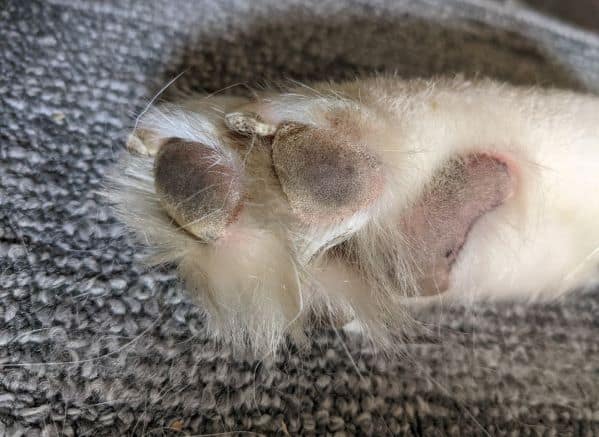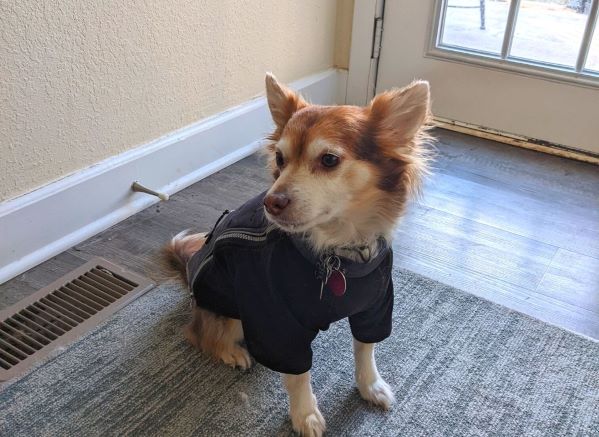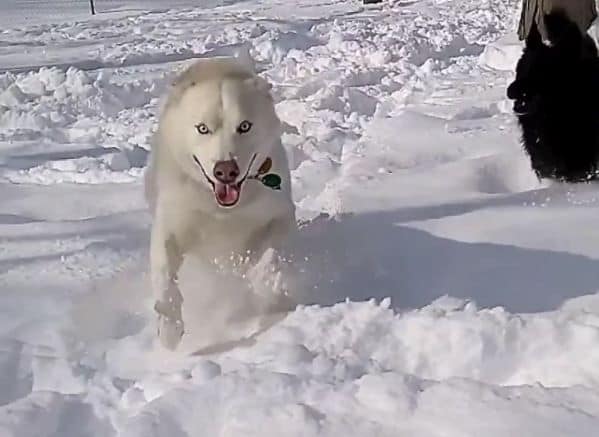Winter Dog Tips
As an Amazon Associate, I earn from qualifying purchases. We may receive a commission for purchases made through these links. This site also contains affiliate links to products besides Amazon, like Etsy. We may receive a commission for purchases made through those links too (at no additional cost to you).
Having Dogs in the Winter
Anyone who has owned dogs in colder climates knows that having dogs in winter can be very different than having dogs during the hot months of summer. You not only have to deal with colder temperatures but your dog will also be introduced to new things and situations. It’s important to prepare both yourself and your pup for all the upcoming changes and learn to make the proper adjustments. These winter dog tips are great for dog owners that live in places where the temperatures will drop and for those who are thinking of traveling to colder places with their pups.

Winter Dog Tips
For a bit of background, I got my first dog, Remington, when I was living in Minnesota where we had long and snowy winters every year. We got the rest of our dogs while we lived in Miami, Florida and they did not see snow or experience cold temperatures until they were 4 and 2 years old when we moved up to Ohio. These are winter tips that I wish someone had shared with me when I had first gotten Remington, and later when we moved our whole crew back up North years later.
Make sure you dog is going to the bathroom when you let them outside.
Much like humans, many dogs don’t love being outside for long when it is super cold out. Some dogs will go outside and immediately ask to be let back in so they can be warm again. They do this before they can fully use the bathroom which can lead to accidents in your home. To prevent this issue, make sure that your dog is fully emptying their bladder when you let them out, even if it means you must go outside too.

Introduce your dog to baggy coats, and long sleeves.
One of the most surprising things about bringing our dogs up North was their reaction to cold-weather clothing. People in heavy, bulky winter coats, hats, gloves, and scarves/masks, were scary. This made sense when I thought about it. Suddenly they had large bulky creatures staggering towards them (no one walks normally with multiple layers on) and they didn’t know if these new creatures were safe or dangerous.

Another thing to be mindful of is the first time your dog is around people wearing long sleeve shirts. Not all dogs will realize that there is a human arm inside a baggy sleeve. Take the time to show them by pulling your sleeve up and down your arm so they don’t accidentally bite it because they think it’s a toy. This is especially important with dogs who love playing tug or that will be around children.
Watch for black ice and slippery snow/grass.
If your dog is high-energy, excited, or has never experienced winter before, it will be your job to gauge the safety of your surroundings. You may need to keep your dog on a leash if there is a lot of ice on the ground and be willing to take a different route or walk in the snow instead of the sidewalk if you decide it’s too dangerous. Be especially careful of stairs. Ice cleats can also make your walk safer.

Your dog may not be equipped to tell when places are slippery. It may be cute to watch videos of pups sliding across the ice, however, slips and slides can often lead to injuries of both dogs and humans. I’ve seen dogs run and slide full speed into people at dog parks which resulted in the person breaking an arm or leg. Your dog also may end up with a break or sprain after a bad slip on ice or snow.
Watch out for surprise finds.
Snow can cover a lot of surprises that your dog may find with their awesome sense of smell. Keep an eye out on what they may pull out from the snow so you know if you need to take it away from them. You might want to keep a pair of gloves on you in case it is something really gross (One of our dogs once pulled out a half-decayed squirrel from a snowbank).

Be mindful of road and sidewalk salt.
Most salt used on public roads and sidewalks is made from sodium chloride which is not pet-safe. Too much exposure to this can harm their paws and if they accidentally ingest it (by licking their feet), it can lead to digestive issues. Try to buy and use pet-safe brands in and around your house in the spaces where your dogs will be walking.

To avoid potential issues, try to keep them in the snow or have them wear boots to protect their feet from the corrosive chemicals in rock salt. You should also wipe their feet off before they come into the house. This is so the rock salt doesn’t stay on their feet too long and limits the odds of them ingesting it by licking it off. This should be done even if you use pet-safe brands as none of them are good for our pets to ingest (Pet MD).
Check their feet periodically when outside.
When playing or walking outside, make sure to keep an eye on their feet. You will want to watch for signs of frostbite, irritation from road salt, and snow clumping to their paw hair. Some types of dog hair will start to collect balls of snow around their toes and ankles. These dogs will start to limp and slow down but others may continue to ignore the discomfort and continue playing if they are having fun.

Watch closely and do regular checks so you can bring them inside before they hurt themselves. If you are worried about your pups’ feet, you might want to consider buying them boots or salve.
Don’t let them get too cold.
If your dog is having a ton of fun playing in the snow, they might ignore any discomfort they may start to feel. In this case, it will be up to you to decide when it is time for your dog to take a break and warm up inside before they get too cold or start to suffer from frostbite. You can always make them some DIY dog enrichment to help them burn off energy indoors if it is too cold for them to play outside safely.

Invest in proper winter gear.
To survive winter with your pup, you will want to buy winter gear for both you, and your dog. For humans, this can be snow pants, gloves, winter boots, and ice cleats. For dogs, this might involve boots, salve, coats, sweaters, or leg warmers.

Some dogs will need winter gear no matter how long they will be outside or how cold it gets. Smaller dogs and breeds like greyhounds simply are not built to survive colder weather so it is important to get the proper clothing to wear. Some dogs will be ok with a simple shirt while others will need to wear a thick insulated jacket.
Energy levels will be different.
With colder weather, lots of dogs are more energetic when they play outside. At the same time, playing in the snow can be more tiring due to the constant resistance when they are walking or running in it. Don’t get too worried if your dog seems extra tired after a snowy play session.

At the same time, be mindful of how long they play outside in the snow if they have any medical issues such as arthritis or old injuries. The extra work their joints and muscles need to do in order to move around in the snow can aggravate certain conditions. This can result in needing extra supplements or medications after outside outings or even a time limit on how long they can play in certain weather conditions. Our oldest gets Clean Remedies CBD for pets and/or Rovera/Carprofen which is a prescription from his vet.
Keep them hydrated.
Remember that it is possible to become dehydrated in the cold. You will want to have water on hand when you are traveling with your dog in the winter months. Most outdoor public water sources will be turned off to keep pipes from freezing so you will have to bring your own.

When going to a park for a few hours, you can always fill your bottles up with warm or hot water to prevent them from freezing too quickly. If you are traveling longer distances, remember that any water kept in your vehicles may also freeze so you will want to be careful what you leave in your car.
*Liquid expands when it freezes so NEVER leave a full bottle in your vehicle. The container can break or even explode leaving a huge mess.
Their hair will probably change.
Once it turns cold, your dog’s coat may naturally become thicker. When dogs live in colder environments, their hair tends to adapt. All four of our dogs ended with thicker, bushier coats after we moved back up north.

You should also prepare yourself for more than normal shedding when temperatures fluctuate and during season changes. So much shedding. This is natural as their bodies continue to adapt to the changing environment around them.
Have Fun and Stay Warm!
Snow can be a fun experience for both of you as long as you are prepared. I hope these winter tips help you and your dog get ready to enjoy the colder months. May your cold-weather memories be fun and epic no matter if you live in a place where the winters are cold or you decide to take your furry friend to see snow for the first time!
Don’t forget to join our Facebook group for Traveling Pet Owners for a safe space to ask questions and get ideas on how to make traveling with your pets a positive experience.
Pin For Later:

Amazon and the Amazon logo are trademarks of Amazon.com, Inc, or its affiliates.







Awww, pups need to be warm! Thank you for sharing these important tips!
Your welcome! Hope it helps 🙂
Good info! My dog is 1 year old so I need all the tips I can get, especially from this post because I live in cold snowy Switzerland!
Hope it helps with this first winter! Sometimes I miss the puppy phase 🙂
These are great winter dog care tips and great doggy photos to accompany them haha. We just got a huge amount of snow overnight, taller than my little guy. He has to get used to going to the bathroom in a different area now which he’s pretty picky about. Great tip with checking their paws too and the salt. It’s so easy for the salt to get stuck in between their little toes and cause greater issues.
Thanks! Glad you liked the photos 🙂 We try to shovel a part of the yard for our smallest dog but have to keep on top of keeping it ‘clean’ enough for him cause he can be picky too
Oh boy! Now when I read this I see how much work it takes to keep a dog safe at winter. You guys are such a good owners:)
Awww, thank you! It can be work, but totally worth it!
And teach them not to attack the sled as it’s going down the hill 😂. Great suggestions for our furry friends.
That too! LOL!!! So many things that you don’t think about until its happening 🙂
These are great tips for wintering with dogs. I don’t have a dog any more but I help care for my daughter’s and my mom’s. They don’t linger outdoors when it’s cold!
We have two that want to stay out in the cold forever and two that want to come in right away. The smallest one is the one we need to make sure uses the bathroom before he comes back in, SMH
Great tips for dog owners. I have a cat and he stays indoors. It’s a perfect fit for me. However, dogs are great and deserve to be cared for probably because they give so much back.
My dogs help make sure I get outside year-round, which is great for my mental health. I’m glad you have a pet that fits your needs 🙂
Amazing tips! Thank you for sharing.
It never occurred to me that a dog from a warm climate wouldn’t realize what bulky clothing and long sleeves are.
Me either….until they grabbed my arm! In Florida we wore tank tops and short sleeve shirts LOL
We just woke up to snow in Chicago, so this blog post is very timely. My pup really hates the salt.
I think I jinxed us with the winter posts! We just got hit too after the Winter Road Trip Tips went live…sorry! LOL
Learnt so much from your useful post. I did not know about the salt on the sidewalks injuring their paws, will make sure I soak her paws in lukewarm water when we return home after our walks in winter. Thank you, for the great tips.
Some dogs are more sensitive than others but it’s definitely not something any of them should accidentally ingest 🙂